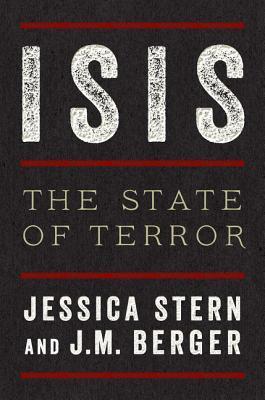What do you think?
Rate this book


432 pages, Kindle Edition
First published January 1, 2015
…violent apocalyptic groups are not inhibited by the possibility of offending their political constituents because they see themselves as participating in the ultimate battle. Apocalyptic groups are the most likely terrorist groups to engage in acts of barbarism, and to attempt to use rudimentary weapons of mass destruction. Their actions are also significantly harder to predict than the actions of politically motivated groups.For most of us the acronym ISIS conjures up an array of images, mostly of a dark sort. Beheadings, suicide bombers, desert fighters, usually of Middle Eastern extraction, fanaticism, in short, and bloody. All this is pretty much the case, but there is so much more to know about this entity, the latest in a long line of international boogeymen. How did ISIS come to be? What do they want? What differentiates them from other extremist groups? And what might be done about them?



Not only did [ISIS] implement a draconian regime of crime and punishment, which its members believed to be divinely ordained, but it celebrated and painstakingly documented the process in its propaganda, publicizing everything from the destruction of cigarettes and drug stashes to the amputation of thieves hands ‚Äúunder the supervision of trained doctors‚Ä� to the genocidal extermination and enslavement of Iraqi minorities.One of the many extreme measures ISIS employs has been called ‚Äútotal organization.‚Ä� This is an attempt to remove all influence from prior or outside cultures. It includes a monopoly on education and control of all aspects of life, a truly totalitarian approach. This technique was employed by Pol Pot in the 1970s in Cambodia. A related ISIS practice is to recruit and train children for combat, an internationally recognized war crime. Long term exposure to extreme violence can erode moral concerns, as young people become inured to death and killing. It encourages an extreme quest for purification, and woe to anyone deemed inadequately pure.
In many ways, the combination of elements was unprecedented. Nazi Germany, whose parallels in propaganda and brutality often invited comparisons to ISIS, had produced masterful propaganda while carrying out a painstakingly documented program of genocide, but these were separate efforts. Its propaganda did not celebrate the genocide; rather it served to justify an imperative to act in the name of national and racial purity without sharing the gruesome reality. The Nazis did not broadcast their atrocities to the world.
In stark contrast, ISIS presented its vision of a demented utopia in which children played with severed heads and ran laughing down streets lined with mangled bodies instead of trees. A seemingly endless procession of atrocities was captured in photographs and videos, and distributed through both official and unofficial channels on social media.

"The West has too often found itself fighting the last war, when the next war is taking shape before its eyes. Faced with the expansionist, populist rise of ISIS, we cannot afford to keep making that mistake."The authors describe the online presence of ISIS and the methods used to gain followers through media sites. The Twitter Wars fought among splinter ideologues and referred to in newspaper reports are laid out in ravishingly detail, and the analysis is explicit and thoughtful. Especially interesting is the informed discussion on whether attempts to limit ISIS participation on social media sites controlled by U.S. organizations (i.e., Twitter, Facebook, etc.) helps or hurts attempts to reign in ISIS influence.
"‚ĶEmpathy can‚Ķbecome attenuated‚Ķwhen a person is too often severely frightened, too often victimized, or too often involved in perpetrating violence. Frequent exposure to savagery is one way to reduce a person‚Äôs capacity to feel. When a person is trained, or trains himself, to feel less empathy and its absence becomes a trait, he becomes capable of dehumanizing others, putting him at risk of acts of extreme cruelty. In our view, ISIS is using frequent exposure to violence as a technology to erode empathy among its followers."This theory helps to explain why ISIS is involved in teaching and training young children‚Äîthe younger the better‚Äîin weapons training and inculcation: ‚Äúyoung children are easier to mold into ISIS‚Äôs vision of this new man...Leadership decapitation is significantly less likely to be effective against organizations that prepare children to step into their fathers‚Ä� shoes.‚Ä� Regarding desensitization to extreme violence, ‚Äúresidents of Raqqa report‚Ķthat children are taught how to behead another human being, and are given blond dolls on which to practice.‚Ä�
‚ÄùWe must find better ways to balance our security against common sense and widely accepted ethical principles. That means refusing to rush in to war every time we are invited by someone waving a black flag, but it also means taking a closer look at our strategies and tactics, and asking how they can better reflect our values. In the conflict with ISIS, messaging and image are half the battle, and we do ourselves no favors when we refuse to discuss the negative consequences of our actions.‚Ä�Jessica Stern is a policy analyst specializing in terrorism affiliated with Harvard‚Äôs School of Public Health and the Hoover Institution Task Force on National Security and Law. J.M. Berger is a nonresident fellow in the Project for U.S. Relations with the Islamic World at the Brookings Institution. Both appear to have closely monitored the appearance and development of ISIS outreach online, and seem to be defining a new kind of war that has enormous implications for how we live our lives now and in the future, to say nothing of how we fight.
ISIS is the crack cocaine of violent extremism, all of the elements that make it so alluring and addictive purified into a crystallized form.